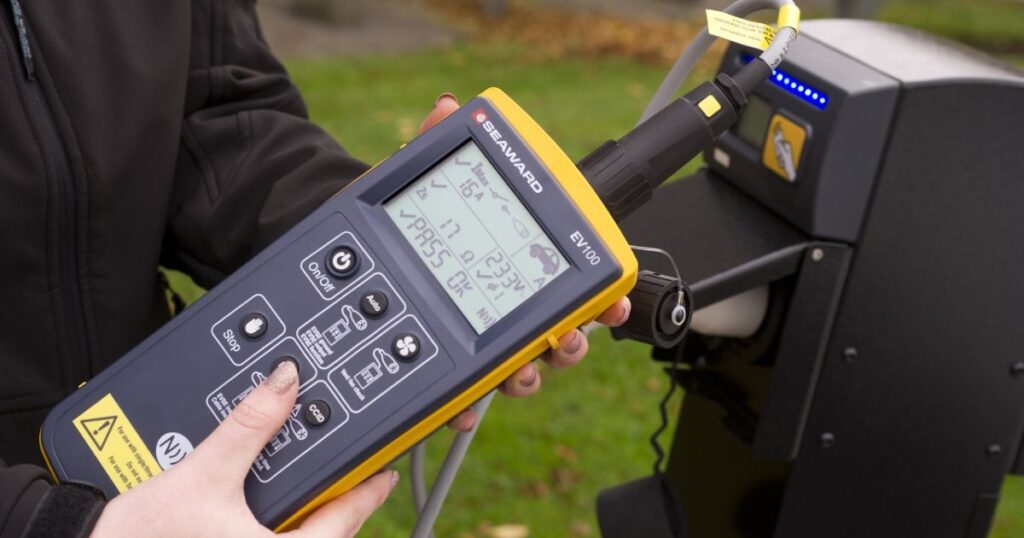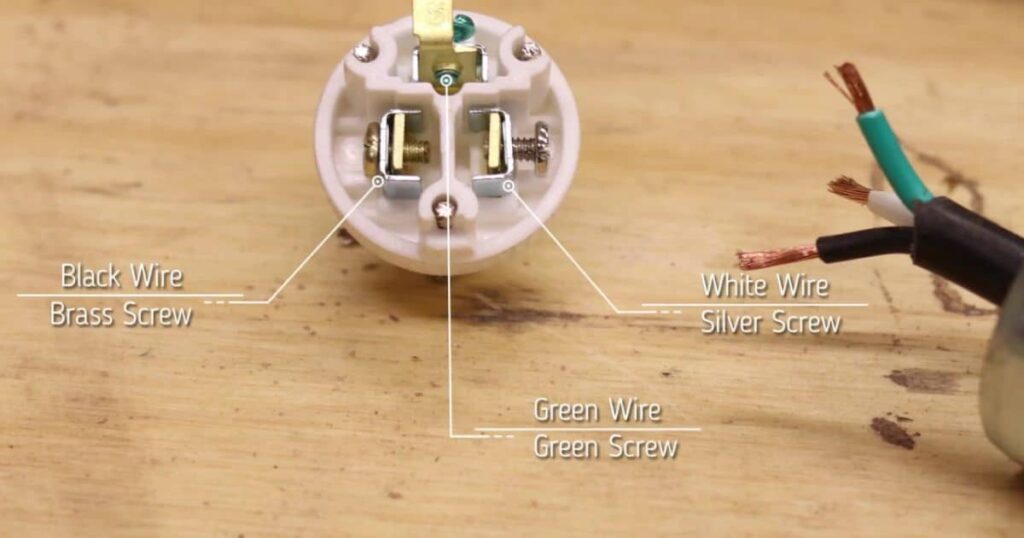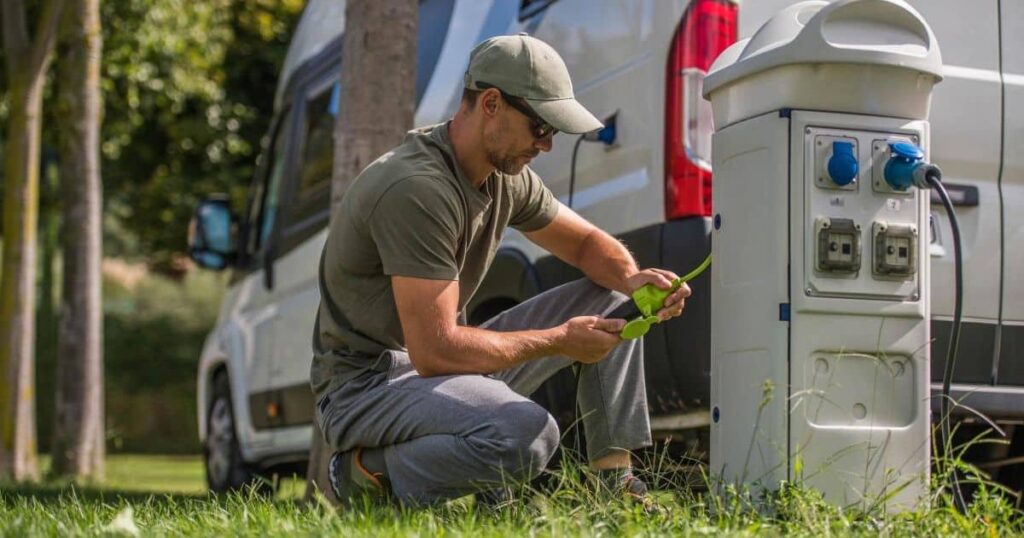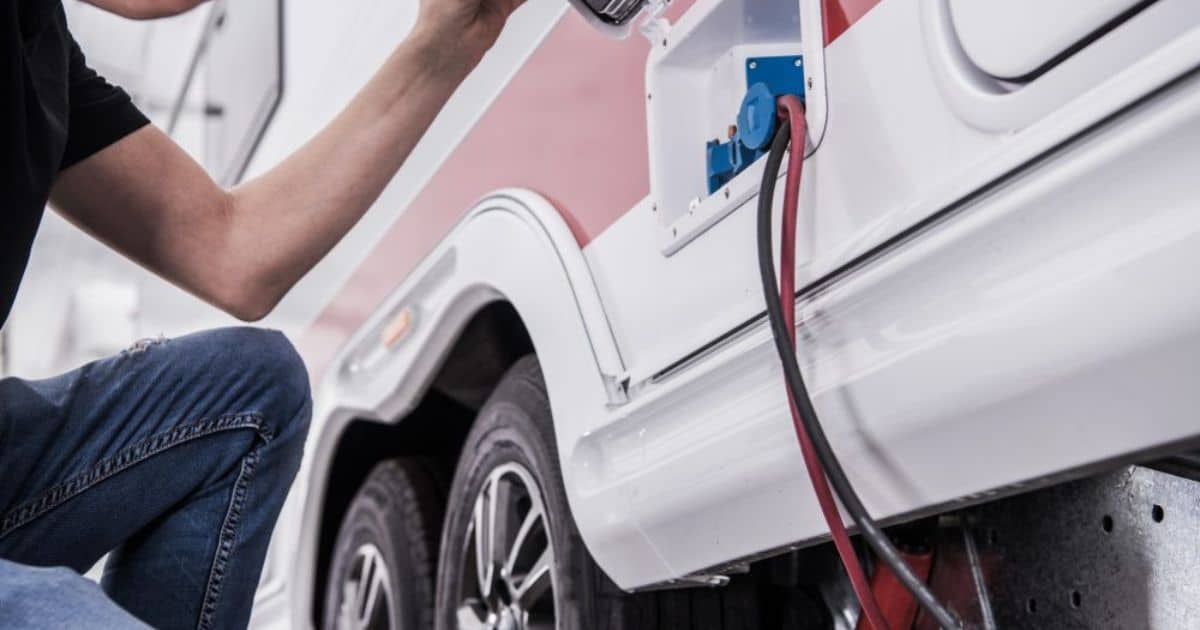When it comes to the world of recreational vehicles (RVs), understanding the electrical system is crucial for a smooth and enjoyable camping experience. One common question that often arises is whether a 50 Amp RV service operates on 110 volts or 220 volts. In this comprehensive guide, we will delve into the intricacies of RV electrical systems, explaining the differences between 110 and 220 volts, and providing valuable insights for RV enthusiasts.
The RV Voltage Can Be Determined Through the Plug Design
Understanding the voltage of an RV can often be simplified by examining the design of the plug. The plug configuration not only determines the maximum current the RV can handle but also provides valuable insights into the voltage it operates on.
Decoding the 30 Amp RV Plug Design
A typical 30 Amp RV plug features three prongs—a single 120-volt hot leg, a neutral wire, and a ground wire. This configuration is indicative of the RV’s reliance on a 120-volt electrical system. If you encounter a campsite with a 30 Amp power supply, your RV will likely have this distinctive plug, signaling that it operates on a standard household voltage.
Unveiling the 50 Amp RV Plug Design
The 50 Amp RV plug, on the other hand, boasts a more intricate design with four prongs—two 120-volt hot legs, a neutral wire, and a ground wire. This plug configuration is a clear indication that the RV is equipped with a 50 Amp electrical system, providing the capability for dual 110-volt lines. Spotting this plug allows RV enthusiasts to identify not only the increased capacity but also the potential for running multiple high-powered appliances simultaneously.
Adapters and Understanding Compatibility
For RVers who frequently travel to different campsites, adapters become essential tools for ensuring compatibility with varying power supplies. While these adapters enable RVs to connect to different amperage outlets, it’s crucial to recognize that the plug design doesn’t change. Even when adapting to a lower amperage outlet, the original plug design of the RV remains unchanged, maintaining its voltage characteristics.
Safety Considerations and Electrical Compatibility
Understanding the voltage of your RV through the plug design is not only about convenience but also about safety. Plugging into an outlet with the wrong voltage can result in damage to your RV’s electrical system and appliances. Therefore, before connecting to a power source, always double-check the plug design and ensure it aligns with your RV’s specifications.
Regular Inspections for Wear and Tear
In addition to identifying the voltage, it’s crucial for RV owners to regularly inspect their plugs for signs of wear and tear. Damaged plugs can compromise the electrical connection, leading to potential hazards. Replace any worn-out plugs promptly to maintain a secure and reliable electrical system in your RV.
Professional Assistance for Modifications
For RVers considering modifications or upgrades to their electrical systems, seeking professional assistance is highly recommended. Altering the voltage of an RV requires expertise to ensure that the modifications comply with safety standards and do not pose risks to the RV or its occupants.
Why Do RVs Have Different RV Electrical Services?

Understanding why RVs come with different electrical services is crucial for RV owners to make informed decisions about their power needs. RV manufacturers offer various electrical service options to accommodate the diverse requirements of different RV models and the varying needs of RVers. Let’s explore the reasons behind the existence of different RV electrical services.
Factors Influencing RV Electrical Services
| 1. Size and Type of RV: | Larger and more luxurious RVs often come equipped with higher electrical capacities. Class A motorhomes, for example, may have 50 Amp electrical services to power numerous appliances simultaneously. Smaller RVs, such as pop-up trailers, might have 30 Amp or even 15/20 Amp services due to their reduced power demands. |
| 2. Appliance Power Requirements: | The type and number of appliances installed in an RV play a significant role in determining the electrical service required. RVs with energy-intensive appliances like residential-style refrigerators, large air conditioners, or washer/dryer units may need higher amperage services to function optimally. |
| 3. Travel Preferences: | RVers who frequent campgrounds with varying electrical hook-up options may prefer a more versatile electrical system. This is where the adaptability of a 50 Amp service, which can be adapted to 30 Amp or standard 15/20 Amp outlets, becomes advantageous. |
| 4. Full-Time RV Living: | RVers opting for full-time living in their RVs may lean towards models with higher electrical capacities. Full-timers often have more appliances and electronic devices onboard, making a 50 Amp service desirable for its ability to handle increased power demands. |
The Role of 30 Amp and 50 Amp RV Services
| 1. 30 Amp RV Service: | A common and versatile electrical service, the 30 Amp RV service, provides a single 110-volt line and is suitable for powering a range of appliances in smaller to mid-sized RVs. It is a standard offering in many campgrounds, making it a practical choice for RVers with moderate power needs. |
| 2. 50 Amp RV Service: | With its dual 110-volt lines, the 50 Amp RV service is designed for larger RVs with increased power requirements. This service configuration allows for the simultaneous operation of multiple high-demand appliances, making it ideal for RVers who enjoy a more luxurious camping experience with amenities like large air conditioners, electric stoves, and residential-style refrigerators. |
Considerations When Choosing an RV Electrical Service
| 1. Camping Style: | Consider your typical camping environment. If you frequent campgrounds with varying electrical hook-ups, a 50 Amp service with adapters for 30 Amp and standard outlets provides adaptability. |
| 2. Appliance Usage: | Assess the power requirements of your onboard appliances. If your RV features energy-intensive appliances, a higher amperage service may be necessary for optimal performance. |
| 3. Future Upgrades: | If you plan to upgrade or add appliances to your RV in the future, it’s wise to choose a model with a higher electrical capacity to accommodate potential power demands. |
Definitions of an RV Electrical Service
Understanding the nuances of an RV electrical service is fundamental to deciphering the difference between 110 and 220 volts. Let’s delve into key definitions that will shed light on the intricacies of RV electrical systems.
Alternating Current (AC) in RVs
One of the foundational concepts in RV electrical systems is alternating current (AC). Unlike direct current (DC), which flows in a single direction, AC periodically changes direction. Most RV appliances and electrical systems operate on AC, making it essential to comprehend for efficient energy distribution within the vehicle.
Circuit Breaker and Its Role in RV Safety
A circuit breaker is a crucial safety component in RV electrical systems. Its primary function is to protect the system from overloads or short circuits by interrupting the flow of electricity. In the context of a 50 Amp RV service, the circuit breaker ensures that the system does not exceed its maximum capacity, safeguarding both the RV and its occupants.
Shore Power and Its Connection to RVs
Shore power refers to the electrical power source provided by a campsite or external outlet when an RV is parked. RVs can be plugged into shore power to run appliances, charge batteries, and operate the entire electrical system. Understanding how shore power integrates with the RV electrical service is pivotal for seamless camping experiences.
The Measurement of Electrical Current – Amps
A fundamental aspect of RV electrical systems is the measurement of electrical current, which is expressed in amperes (amps). The 50 Amp RV service, commonly found in larger RVs, signifies the system’s capability to handle up to 50 amps of current. This higher capacity allows for the simultaneous operation of multiple high-energy appliances, providing a more versatile and comfortable living experience on the road.
Applying Definitions to 110 and 220 Volts in RVs
Now that we’ve clarified these foundational definitions, let’s apply them to the differentiation between 110 and 220 volts in RV electrical systems.
Understanding AC Voltage – 110 Volts in RVs
In the realm of RVs, the standard operating voltage is 120 volts, often referred to colloquially as 110 volts. This voltage is delivered in alternating current, ensuring compatibility with most RV appliances. Recognizing the role of AC voltage in the 110-volt system is vital for choosing and operating appliances efficiently.
Dual 110-Volt Lines – The Essence of 220 Volts in RVs
Contrary to the misconception that RVs operate on 220 volts, the reality is that a 50 Amp RV service provides dual 110-volt lines. This configuration enables the simultaneous use of multiple high-demand appliances, offering enhanced flexibility to RVers. The understanding of shore power, circuit breakers, and the measurement of electrical current becomes especially relevant when dealing with the increased capacity of a 50 Amp system.
Amps Measure Speed Of The RV Electrical Service

Understanding the speed at which electricity flows through your RV’s electrical system is crucial for maintaining a reliable and efficient power supply during your travels. This speed is measured in amperes or, more commonly, amps. In the realm of RV electrical services, the amp rating is a key factor in determining the system’s capacity and overall performance.
Amps and Electrical Flow
Amps represent the quantity of electrical current flowing through a circuit. In the context of RVs, the amp rating reflects the maximum amount of current the electrical system can handle. Higher amp ratings indicate a greater capacity for powering multiple appliances simultaneously, making it essential for RVers with energy-intensive needs.
Matching Amps to Appliances
To ensure the seamless operation of your RV’s electrical system, it’s vital to match the amp rating with the requirements of your appliances. Overloading the system with more amps than it can handle may lead to tripped circuits or, in more severe cases, damage to appliances and the RV’s electrical components.
Impact on 50 Amp RV Service
The 50 Amp RV service, with its dual 110-volt lines, provides a higher amp rating compared to the more common 30 Amp service. This increased capacity allows for a faster and more robust flow of electricity, catering to the demands of larger RVs and those equipped with power-hungry appliances.
Voltage (V) is the Energy For The RV Electrical Service
Voltage (V) serves as the lifeblood of any RV electrical system, dictating the energy that flows through the circuits and powers the various appliances on board. In the context of RVs, the standard operating voltage is 120 volts, often referred to as 110 volts for historical reasons. This voltage is essential for running common appliances like refrigerators, lights, and entertainment systems.
In the case of a 50 Amp RV service, the mention of 220 volts is a bit of a misnomer. Instead, the service provides dual 110-volt lines, enabling the simultaneous operation of multiple high-powered appliances. The wiring configuration, featuring a four-pronged plug, accommodates this dual voltage setup. Understanding the role of voltage is paramount for RV enthusiasts, ensuring they can efficiently and safely harness the energy needed for a comfortable and functional life on the road.
RV 220 to 110 Adapter
RV enthusiasts often find themselves in campsites with varying electrical hookups. The RV 220 to 110 adapter comes to the rescue in such situations. This adapter allows RV owners with a 50 Amp service to connect to 220-volt outlets when needed. It typically features a 50 Amp female connector on one end and a 30 Amp or standard 15/20 Amp male plug on the other. While these adapters provide flexibility, it’s crucial to exercise caution and be aware of the limitations to prevent overloading the RV’s electrical system.
Is My RV 30 or 50 Amp?
Determining whether your RV is equipped with a 30 Amp or 50 Amp electrical system is fundamental for safe and efficient power management. One straightforward method is to check the power cord. A 30 Amp RV will have a single hot leg, while a 50 Amp RV will feature a power cord with four prongs, indicating dual 110-volt lines. Additionally, RV owners can refer to the owner’s manual or inspect the electrical panel to identify the amp rating of their RV.
Can I Plug My RV Into 220V?
While RVs primarily operate on 120 volts, the question of whether you can plug your RV into 220 volts often arises. The answer depends on the electrical system in your RV. If you have a 50 Amp RV service, equipped with dual 110-volt lines, you can use a 220 to 110 adapter to connect to a 220-volt outlet. However, it’s crucial to ensure that your RV’s electrical system can handle the higher voltage and that you are using the appropriate adapters to avoid damaging your RV’s appliances and electronics.
How to Wire a 50 Amp RV Plug?

Wiring a 50 Amp RV plug is a task that RV owners may need to undertake, especially when setting up a new electrical connection. The process involves a four-pronged plug configuration with two hot legs, a neutral wire, and a ground wire. It’s essential to follow the manufacturer’s guidelines and adhere to local electrical codes to ensure safety and compliance. Additionally, RV owners should consider consulting a professional electrician if they are unfamiliar with electrical wiring to guarantee a secure and reliable connection.
Watts (W) – The “Pressure” Of The RV Electrical Service
Understanding watts is crucial in deciphering the overall capacity and capability of your RV electrical service. Watts, often referred to as the “pressure” of the electrical system, represent the total power consumption or production. In the context of RVs, it’s a measure of how much electrical energy your RV can handle or generate at any given moment.
For a 50 Amp RV service, the total power capacity is calculated by multiplying the voltage (typically 120 volts) by the current (50 amps). This results in a robust 6,000 watts of power. Knowing the watts your RV electrical service can handle is essential for managing your appliances and devices effectively, ensuring you stay within the limits of your RV’s electrical capabilities and enjoy a hassle-free camping experience.
Calculating The Amps Of The RV Electrical Service
Understanding the amperage of your RV electrical service is crucial for managing power consumption and ensuring the safe operation of your appliances. The amperage rating indicates the maximum current that the electrical system can handle. To calculate the amps of your RV electrical service, you can use a straightforward formula:
Formula: Amps = Watts / Volts
This formula helps you determine the amperage by dividing the total power consumption in watts by the voltage of the electrical system. For example, if you have a 120-volt system and your appliances collectively draw 2400 watts, the calculation would be:
Amps = 2400 watts / 120 volts = 20 amps
This result indicates that the total current draw is 20 amps. Keep in mind that understanding the amps is crucial when determining whether your RV electrical service is appropriately sized for your needs and if you can safely operate multiple appliances simultaneously without overloading the system. Always ensure that the total amps of your appliances do not exceed the capacity of your RV electrical service to prevent electrical issues and ensure a smooth camping experience.
Calculating The Voltage Of The RV Electrical Service
Understanding the voltage of your RV electrical service is essential for optimal performance and safety. The voltage in an RV electrical system, particularly in a 50 Amp service, is determined by the combination of the two independent 110-volt lines. To calculate the voltage, you can use the following formula:
Formula: Voltage (V) = Hot Leg 1 (V) + Hot Leg 2 (V)
In this formula:
- Voltage (V) represents the total voltage output of the RV electrical service.
- Hot Leg 1 (V) corresponds to the voltage output of the first 110-volt line.
- Hot Leg 2 (V) corresponds to the voltage output of the second 110-volt line.
By adding the voltage values of the two hot legs, you get the total voltage supplied by the 50 Amp RV service. This calculation is crucial for RVers who want to ensure they are utilizing the full capacity of their electrical system or for those who may need to distribute power strategically among different appliances. Always remember to prioritize safety and adhere to the recommended voltage specifications of your RV and its appliances.
Calculating The Watts Of The RV Electrical Service

Calculating the watts of an RV electrical service involves a straightforward formula:
Watts=Volts×Amps
Watts=Volts×Amps
For a 50 Amp RV service operating at 12
0 volts, the calculation would be:
Watts=120 volts×50 amps=6000 watts
Watts=120volts×50amps=6000watts
Understanding this formula allows RV enthusiasts to assess the power consumption of their appliances and ensure they stay within the capacity of their electrical system.
Frequently asked Questions
Is a 50 amp RV plug 120 or 240?
A 50 amp RV plug is 240 volts.
Can you run a 50 amp RV on 110?
No, you cannot run a 50 amp RV on 110 volts; it requires 240 volts.
What happens if I plug my RV into 220v?
If you plug your RV into 220 volts instead of the required 240 volts, it may lead to electrical issues.
How is a 50 amp RV service wired?
A 50 amp RV service is wired with two hot legs of 120 volts each and a neutral, totaling 240 volts.
Conclusion
In conclusion, the question of whether a 50 Amp RV service operates on 110 or 220 volts can be clarified by understanding the dual 110-volt lines provided by the service. While the standard operating voltage is 120 volts, the configuration of the system allows for increased capacity, making it suitable for RVers with high-energy requirements. Whether you’re a seasoned RVer or a newcomer to the world of recreational vehicles, a clear understanding of your RV’s electrical system is paramount for a safe and enjoyable camping experience.











